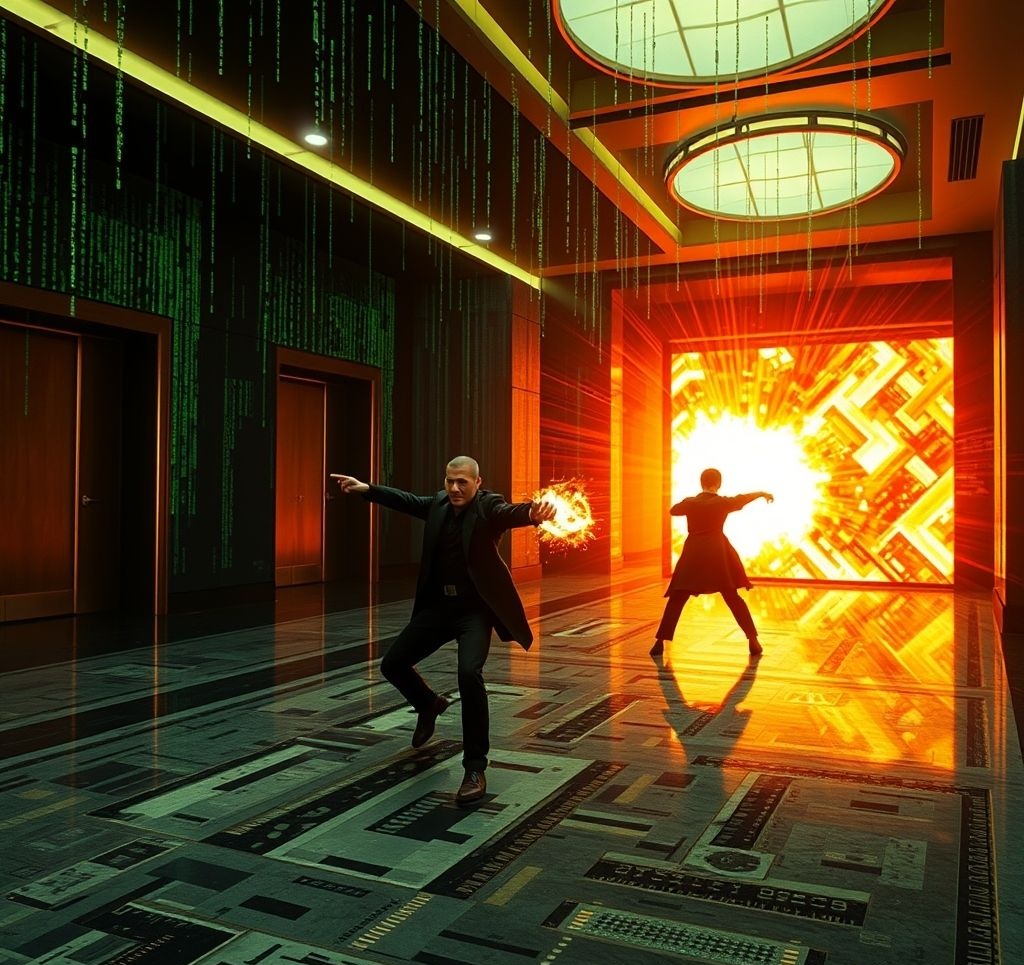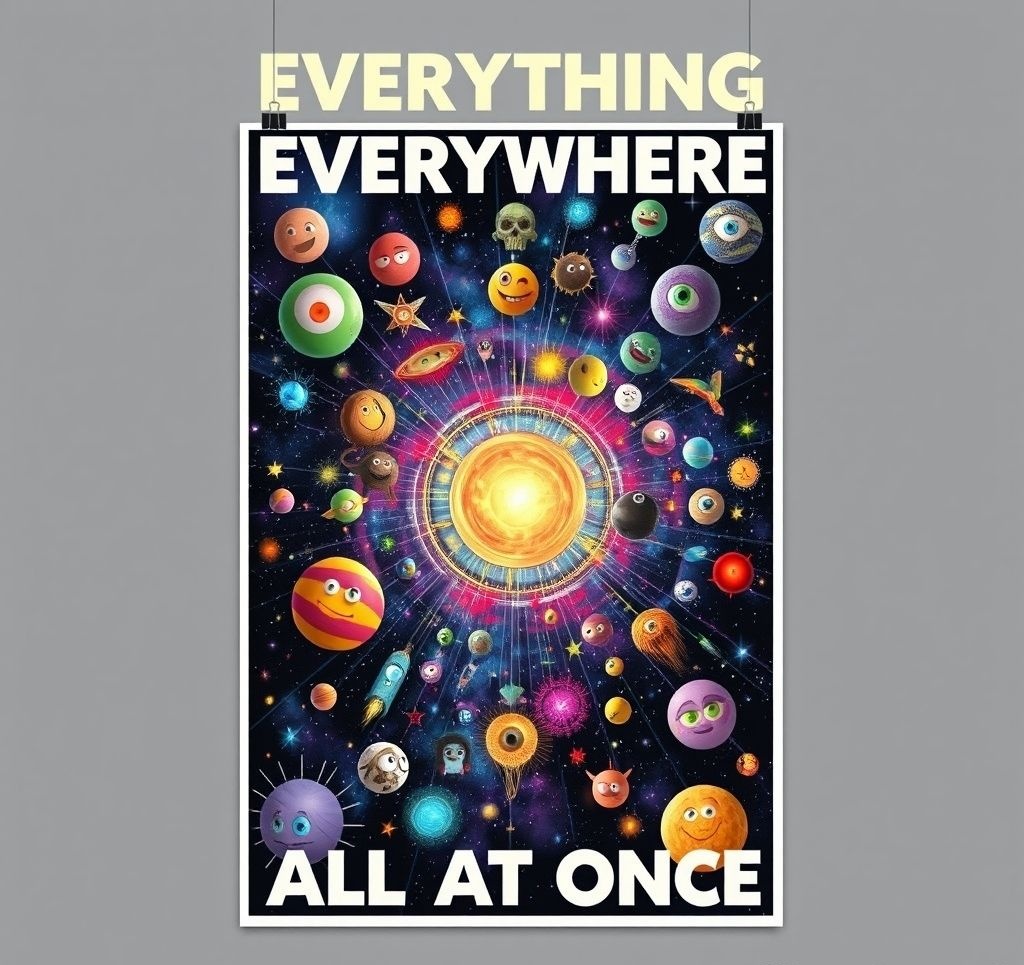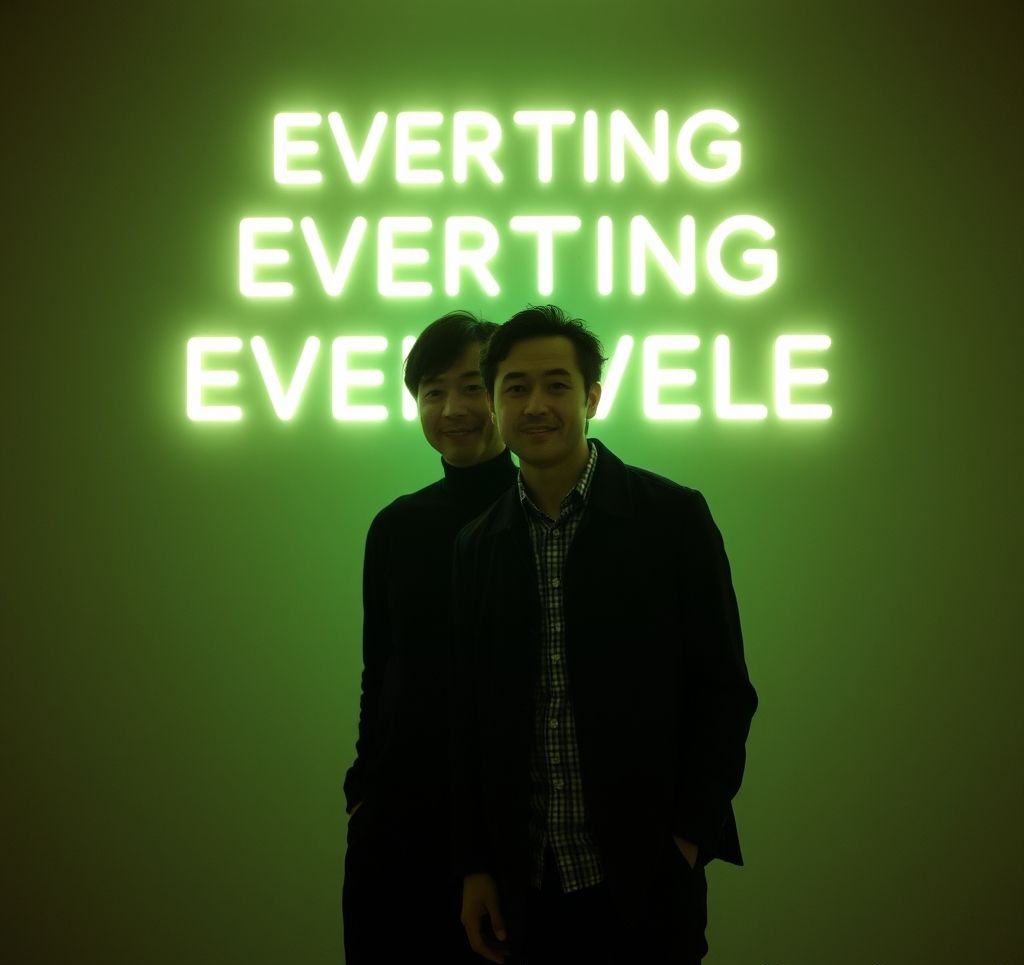Evelyn Wang (Michelle Yeoh) is an exhausted Chinese-American immigrant who runs a failing laundromat with her kind-hearted husband Waymond (Ke Huy Quan). Their marriage is strained, her relationship with her lesbian daughter Joy (Stephanie Hsu) is fractured, her demanding father Gong Gong (James Hong) has just arrived from China, and the family faces an IRS audit conducted by the unforgiving agent Deirdre Beaubeirdre (Jamie Lee Curtis). As they sit in Deirdre's office, Evelyn's life is suddenly upended when an alternate version of her husband, "Alpha Waymond," temporarily takes over his body.
Alpha Waymond reveals that the multiverse—infinite parallel universes containing different versions of themselves—is real, and that it's being threatened by Jobu Tupaki, an omnipotent being who has created a black hole-like "everything bagel" that could destroy all existence. He explains that Evelyn is uniquely positioned to stop Jobu because her many failures have made her the "worst possible version" of herself, leaving untapped potential to access skills from her alternate lives. As Alpha Waymond teaches Evelyn "verse-jumping"—the ability to access other versions of herself across the multiverse—she discovers lives where she became a movie star, a chef, a sign spinner, a blind opera singer, and even a woman with hot dogs for fingers who's in a relationship with Deirdre.
As Evelyn battles enemies across multiple realities using newly acquired skills ranging from martial arts to sign spinning, she gradually discovers that Jobu Tupaki is actually an alternate version of her daughter Joy. In a universe where Evelyn pushed her daughter too hard to reach her potential, Joy's mind fractured after being forced to verse-jump too many times, turning her into Jobu Tupaki—a nihilistic being who can experience all universes simultaneously and has concluded that nothing matters. The everything bagel represents Jobu's desire to end the pain of existence by destroying everything. Throughout increasingly chaotic confrontations across bizarre universes, Evelyn begins to succumb to the same nihilism, until a crucial emotional breakthrough helps her find meaning in the face of infinite possibilities and reconnect with her family across the multiverse.
Nihilism and Existentialism in a Multiverse Context
At its philosophical core, Everything Everywhere All at Once grapples with existential nihilism—the idea that life has no inherent meaning or purpose—through the lens of multiverse theory. The film's genius lies in how it uses the concept of infinite parallel universes not just as a plot device for spectacular action sequences, but as a framework for exploring profound existential questions. If every possible choice creates a different universe, does any single choice matter? If infinite versions of ourselves exist, making every possible decision, what significance do our individual lives hold?
Jobu Tupaki's "everything bagel" serves as the perfect visual metaphor for nihilism: a black hole containing everything that exists, which paradoxically reveals the meaninglessness of it all. As Jobu explains, "When you really put everything on a bagel, it becomes this. Nothing...a hole where everything is pointless." This reflects philosopher Friedrich Nietzsche's concept of the "eternal return" and the potential despair that comes from cosmic awareness of infinite possibilities.
The film doesn't merely present nihilism as a philosophical position; it embodies it through cinematic form. The increasingly chaotic structure, absurdist humor, and deliberate sensory overload mirror Jobu's fractured experience of perceiving all universes simultaneously. This formal nihilism risks overwhelming the viewer just as it overwhelms Evelyn, making the philosophical journey experiential rather than merely intellectual.
Yet the film ultimately rejects pure nihilism in favor of existentialist response—the notion that even in an objectively meaningless universe, we can create subjective meaning through our choices and connections. Evelyn's climactic realization that "In another life, I would have really liked doing laundry and taxes with you" represents the existentialist victory: choosing to find value in mundane existence not despite the infinite possibilities, but because of them. This reflects philosopher Albert Camus' concept that we must "imagine Sisyphus happy" in his endless task—finding joy not in achieving some grand cosmic purpose, but in embracing life's absurdity with compassion and presence.
Generational Trauma and Immigrant Experiences
Beneath its sci-fi trappings, Everything Everywhere All at Once provides one of cinema's most nuanced explorations of immigrant family dynamics and generational trauma. The film centers specifically on the Chinese-American immigrant experience while making it universally resonant. Evelyn's character embodies the complex pressures facing many immigrants: the haunting "what-ifs" of paths not taken in their home countries, the struggle to meet parental expectations while raising children with different cultural values, and the exhausting navigation of systems designed without them in mind (symbolized by the labyrinthine IRS bureaucracy).
The film explores how trauma can transmit across generations, with Gong Gong's disapproval of Waymond being internalized by Evelyn, who then projects similar expectations onto Joy. This cycle creates what psychologists call "intergenerational trauma," where emotional patterns repeat across family lines. The multiverse conceit allows this theme to be explored literally, showing how different choices might have broken these patterns—while also suggesting that some version of these family dynamics plays out across all possible realities.
Particularly poignant is the film's examination of LGBTQ+ acceptance in immigrant families through Joy's storyline. Her mother's inability to fully embrace her sexuality and her relationship becomes both a specific cultural conflict and a universal metaphor for the struggle between traditional values and modern identities. The film doesn't villainize Evelyn for her difficulties; instead, it compassionately shows how her own traumatic experiences inform her limitations as a parent.
The resolution of this theme comes not through some dramatic moment of perfect understanding, but through small gestures of acceptance: Evelyn introducing Joy's girlfriend to Gong Gong not as a "good friend" but as "her girlfriend," and the simple act of following Joy into the parking lot rather than letting her walk away. These moments suggest that healing generational trauma doesn't require grand gestures or perfect solutions—just consistent small choices to break harmful patterns.
Visual Storytelling and Genre Hybridization
The Daniels' approach to visual storytelling represents a paradigm shift in how multiple genres and tones can be integrated within a single narrative. The film functions simultaneously as martial arts spectacle, family drama, science fiction adventure, absurdist comedy, and existential meditation without any of these elements feeling discordant. This genre hybridization isn't merely stylistic experimentation but serves the thematic exploration of fragmented identity and the infinite possibilities of existence.
The film's visual language evolves throughout its runtime, mirroring Evelyn's expanding consciousness. It begins with constrained, claustrophobic framing in the laundromat and IRS office, using a restricted color palette and conventional editing rhythms. As Evelyn accesses more universes, the cinematography becomes increasingly fluid, the color saturation intensifies, and the editing accelerates to create a sensory experience that captures her overwhelming state of "verse-jumping."
Particularly innovative is how the film uses specific visual techniques to represent different universes: the glamorous movie star timeline employs lush cinematography reminiscent of Wong Kar-wai films; the hot dog fingers universe uses soft focus and romantic lighting typical of melodrama; the animated universe utilizes simple 2D techniques; while the rock universe communicates entirely through static shots and text overlays. Each universe has its distinct visual grammar that communicates not just a different reality but a different way of experiencing reality.
The film's approach to action choreography combines technical precision with conceptual innovation. Rather than merely showcasing spectacular martial arts (though it certainly does), the fight sequences advance character development by physically manifesting Evelyn's internal conflicts. The choreography incorporates everyday objects from Evelyn's laundromat life—clothes, receipt spinners, sex toys—transforming the mundane into the extraordinary in ways that reinforce the film's themes about finding wonder in ordinary existence.
Reinvention of Multiverse Narrative
Released during a period when multiverse narratives were becoming increasingly common in mainstream entertainment (particularly in superhero films), Everything Everywhere All at Once radically reinvents this storytelling device. While most multiverse stories use parallel realities primarily for spectacle or to explore "what if" scenarios with established characters, the Daniels employ the concept as a metaphysical framework for examining universal human experiences of regret, possibility, and choice.
The film's innovation lies partly in how it conceptualizes verse-jumping through mundane, often absurdist actions (paper cuts, eating chapstick, declaring bizarre truths) rather than high-tech devices. This approach democratizes the multiverse concept, making it less about superhuman characters and more about ordinary people accessing extraordinary potential. It also creates a uniquely kinetic visual language where the physical comedy of these actions contrasts with their cosmic significance.
Unlike many multiverse narratives that treat alternative timelines as separate stories, Everything Everywhere All at Once insists on their interconnection. Every universe Evelyn experiences informs her understanding of herself and her relationships in her home reality. This approach avoids the potential emotional detachment that can come with multiverse storytelling (where stakes feel lowered because "other versions" still exist) by maintaining that emotional growth must occur across all versions of a character to be meaningful.
Perhaps most subversively, the film ultimately suggests that the most heroic choice within a multiverse framework isn't to become the most powerful or successful version of oneself, but rather to fully embrace one's actual life with all its limitations and seemingly insignificant moments. This runs counter to the power fantasies that often drive multiverse narratives, positioning radical acceptance rather than exceptional achievement as the true goal.
Everything Everywhere All at Once has already secured its place as a watershed moment in contemporary cinema, demonstrating that formally experimental, conceptually complex films can achieve both critical acclaim and commercial success even without franchise connections. Its record-breaking seven Academy Award wins (the most for any Best Picture winner since Slumdog Millionaire) included historic firsts: Michelle Yeoh became the first Asian Best Actress winner, while the film marked the first science fiction work to win Best Picture.
The film's impact on representation in Hollywood extends beyond these statistical achievements. It has been celebrated for centering middle-aged Asian immigrant characters not as supporting players or cultural stereotypes, but as multidimensional protagonists capable of driving high-concept narratives. Particularly notable is how it revitalized the careers of actors who had been marginalized by the industry—Michelle Yeoh finally receiving a leading role worthy of her talents after decades in Hollywood, Ke Huy Quan returning to acting after leaving the profession due to limited opportunities for Asian actors, and Jamie Lee Curtis winning her first Oscar at age 64.
Commercially, the film demonstrated the viability of original, audacious storytelling in a market dominated by franchises and familiar intellectual property. With its $25 million budget yielding a $140 million box office return, it became A24's highest-grossing film and suggested an audience hunger for innovative narrative experiences that balance intellectual ambition with emotional authenticity. This success has potentially opened doors for other filmmakers with unconventional visions who might previously have struggled to secure funding.
Stylistically, the film's boundary-pushing approach to genre hybridization, visual storytelling, and tonal shifts is likely to influence a generation of filmmakers. Its demonstration that a single film can seamlessly integrate martial arts action, philosophical depth, absurdist comedy, and family drama without compromising any element challenges conventional wisdom about genre constraints and audience expectations. The Daniels' maximalist aesthetic—incorporating everything from Wong Kar-wai homages to googly-eyed rocks to dildo fight scenes—suggests new possibilities for cinematic expression that refuses easy categorization.
Most profoundly, Everything Everywhere All at Once arrived at a cultural moment marked by widespread anxiety, division, and digital oversaturation that mirrors the film's themes of overwhelming possibilities and meaning-making in chaos. Its message that kindness and connection remain possible even in the face of cosmic meaninglessness resonated deeply with post-pandemic audiences searching for emotional anchors in uncertain times. The film's successful navigation of nihilism without succumbing to either despair or facile optimism offers a template for how art can engage with existential challenges while still affirming human dignity and relationships.





